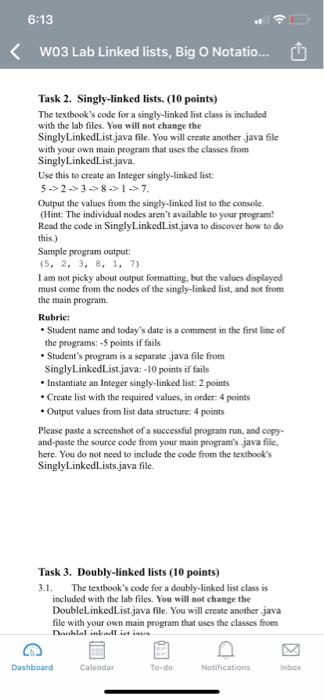Question
java lang /* * Copyright 2014, Michael T. Goodrich, Roberto Tamassia, Michael H. Goldwasser * * Developed for use with the book: * * Data
java lang 
/* * Copyright 2014, Michael T. Goodrich, Roberto Tamassia, Michael H. Goldwasser * * Developed for use with the book: * * Data Structures and Algorithms in Java, Sixth Edition * Michael T. Goodrich, Roberto Tamassia, and Michael H. Goldwasser * John Wiley & Sons, 2014 * * This program is free software: you can redistribute it and/or modify * it under the terms of the GNU General Public License as published by * the Free Software Foundation, either version 3 of the License, or * (at your option) any later version. * * This program is distributed in the hope that it will be useful, * but WITHOUT ANY WARRANTY; without even the implied warranty of * MERCHANTABILITY or FITNESS FOR A PARTICULAR PURPOSE. See the * GNU General Public License for more details. * * You should have received a copy of the GNU General Public License * along with this program. If not, see
// package net.datastructures;
/** * A basic singly linked list implementation. * * @author Michael T. Goodrich * @author Roberto Tamassia * @author Michael H. Goldwasser */ public class SinglyLinkedList
/** The element stored at this node */ private E element; // reference to the element stored at this node
/** A reference to the subsequent node in the list */ private Node
/** * Creates a node with the given element and next node. * * @param e the element to be stored * @param n reference to a node that should follow the new node */ public Node(E e, Node
// Accessor methods /** * Returns the element stored at the node. * @return the element stored at the node */ public E getElement() { return element; }
/** * Returns the node that follows this one (or null if no such node). * @return the following node */ public Node
// Modifier methods /** * Sets the node's next reference to point to Node n. * @param n the node that should follow this one */ public void setNext(Node
// instance variables of the SinglyLinkedList /** The head node of the list */ private Node
/** The last node of the list */ private Node
/** Number of nodes in the list */ private int size = 0; // number of nodes in the list
/** Constructs an initially empty list. */ public SinglyLinkedList() { } // constructs an initially empty list
// access methods /** * Returns the number of elements in the linked list. * @return number of elements in the linked list */ public int size() { return size; }
/** * Tests whether the linked list is empty. * @return true if the linked list is empty, false otherwise */ public boolean isEmpty() { return size == 0; }
/** * Returns (but does not remove) the first element of the list * @return element at the front of the list (or null if empty) */ public E first() { // returns (but does not remove) the first element if (isEmpty()) return null; return head.getElement(); }
/** * Returns (but does not remove) the last element of the list. * @return element at the end of the list (or null if empty) */ public E last() { // returns (but does not remove) the last element if (isEmpty()) return null; return tail.getElement(); }
// update methods /** * Adds an element to the front of the list. * @param e the new element to add */ public void addFirst(E e) { // adds element e to the front of the list head = new Node(e, head); // create and link a new node if (size == 0) tail = head; // special case: new node becomes tail also size++; }
/** * Adds an element to the end of the list. * @param e the new element to add */ public void addLast(E e) { // adds element e to the end of the list Node
/** * Removes and returns the first element of the list. * @return the removed element (or null if empty) */ public E removeFirst() { // removes and returns the first element if (isEmpty()) return null; // nothing to remove E answer = head.getElement(); head = head.getNext(); // will become null if list had only one node size--; if (size == 0) tail = null; // special case as list is now empty return answer; }
@SuppressWarnings({"unchecked"}) public boolean equals(Object o) { if (o == null) return false; if (getClass() != o.getClass()) return false; SinglyLinkedList other = (SinglyLinkedList) o; // use nonparameterized type if (size != other.size) return false; Node walkA = head; // traverse the primary list Node walkB = other.head; // traverse the secondary list while (walkA != null) { if (!walkA.getElement().equals(walkB.getElement())) return false; //mismatch walkA = walkA.getNext(); walkB = walkB.getNext(); } return true; // if we reach this, everything matched successfully }
@SuppressWarnings({"unchecked"}) public SinglyLinkedList
public int hashCode() { int h = 0; for (Node walk=head; walk != null; walk = walk.getNext()) { h ^= walk.getElement().hashCode(); // bitwise exclusive-or with element's code h = (h >> 27); // 5-bit cyclic shift of composite code } return h; }
/** * Produces a string representation of the contents of the list. * This exists for debugging purposes only. */ public String toString() { StringBuilder sb = new StringBuilder("("); Node
Step by Step Solution
There are 3 Steps involved in it
Step: 1

Get Instant Access to Expert-Tailored Solutions
See step-by-step solutions with expert insights and AI powered tools for academic success
Step: 2

Step: 3

Ace Your Homework with AI
Get the answers you need in no time with our AI-driven, step-by-step assistance
Get Started


